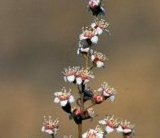COMMENTS ON THE FLORA OF THE FORMER SOVIET SOVIET UNION (FSU)
The flora of the former Soviet Union consists of ca. 20,000
species, which is about the same number as in North America. While the
North American continent is an important source of garden plants, with
ca. 650 native species in cultivation worldwide, far fewer species have
been taken from the former Soviet Union territories, mainly from European
Russia and the Caucasus, fewer from Siberia and the Far East, and very
few from Central Asia. Some regions are practically untapped resources
of promising plants. The reader can find much more detailed analysis of
the role Russia has played in world horticulture is presented in part 4.
Botanists can plumb the depth of this floristic richness from the
Flora of the USSR, and also from many local floras, such as:
Flora of the European part of USSR, Flora of the Caucasus, Flora
Siberia, Flora of the Far East etc. (all included among recommended
literature). Botanical gardens throughout the FSU horticulturally
experiment, and their results show that many native species might
succeed in cultivation. These species belong both to familiar genera
as well as to ones unknown to horticulture.
Among widely known genera, there are some species in the FSU flora
that are rare or completely unknown in cultivation. Examples of this
first group are listed below. The total number of species in the world
flora is taken from Mabberley’s (1987) The Plant-Book, the number
of species in the flora of the FSU from Czerepanov’s (1995)
Vascular plants of the FSU, which is an updated summary of the
Flora of the USSR, or, as was said by its author himself,
"is a critical list of the flora of the territory covered by the former
Soviet Union".
| Genus |
|
World flora |
FSU flora |
| Latin name |
Common name |
(species) |
(species) |
| Abies |
fir |
39 |
8 |
| Acer |
maple |
111 |
30 |
| Actinidia |
kiwi |
30 |
4 |
| Aquilegia |
columbine |
70 |
30 |
| Campanula |
bellflower |
300 |
154 |
| Caragana |
pea tree |
80 |
30 |
| Crataegus |
hawthorn |
280 |
88 |
| Geranium |
cranesbill |
300 |
69 |
| Hemerocallis |
day lily |
15 |
7 |
| Iris |
iris |
300 |
73 |
| Juniperus |
juniper |
50 |
22 |
| Larix |
larch |
9 |
9 |
| Lilium |
lily |
100 |
20 |
| Malus |
apple |
25 |
6 |
| Paeonia |
peony |
35 |
22 |
| Primula |
primrose |
300 |
83 |
| Saxifraga |
rockfoil |
300 |
133 |
| Spiraea |
spirea |
70 |
23 |
| Tulipa |
tulip |
100 |
78 |
| Viola |
violet |
500 |
127 |
Several genera (Tulipa, Paeonia, Campanula,
Iris) are well represented in the flora of the former Soviet
Union. Although horticulturaly significant, certain other genera
are relatively unknown in cultivation. Among these to note are:
| Genus |
|
World flora |
FSU flora |
| Latin name |
Common name |
(species) |
(species) |
| Acantholimon |
prickly-thrift |
120 |
99 |
| Adenophora |
ladybells |
40 |
18 |
| Allium |
onion |
700 |
328 |
| Astragalus |
milk-vetch |
2000 |
800 |
| Corydalis |
corydalis |
300 |
84 |
| Eremurus |
desert candle |
35 |
52 |
| Leontopodium |
edelweis |
35 |
14 |
| Limonium |
sea lavender |
150 |
42 |
| Ornithogalum |
star of Bethlehem |
120 |
28 |
| Rhodiola |
rhodiola |
36 |
21 |
| Scilla |
squill |
40 |
15 |
|
The two figures given under Eremurus are contradictory and
reflect that Russian plants and Russian literature are sometimes
unknown not only to gardeners but also to botanists from other parts
of the world.
Finally, there are some genera which are extremely interesting but
absolutely unknown in cultivation. Among woody plants they are
Louseania ulmiflora (Rosaceae), a Central Asian shrub very
spectacular whith pink flowers; Malacocarpus crithmifolius
(Peganaceae) also from Central Asia and southern Russia, a shrub
with prostrate branches that can grow in extreme environmental
conditions;
Spiraeanthus schrenkianus (Rosaceae), an attractive
shrub with pink flowers in a long panicle from Central Asia. Among
herbaceous perennials the list of unknown genera includes Alfredia,
and Cladochaeta (Asteraceae, or daisy family), Nectaroscordum
(Alliaceae, or onion family); Rhinopetalum (Liliaceae, or
lily family), and Woronowia (Rosaceae, or rose family). These
plants have been seen only in botanical gardens, however, they are of
great horticultural value. Alfredia nivea with leather-like
leaves in rosette is a wonderful plant for rock gardens. Cladochaeta
candidissima is a beautiful groundcover with its grey leaves.
Nectaroscordum is an unusual plant, closely related to onion,
1 m in height, that can be used for group planting. Rhinopetalum
is a bulb plant with pink or white flowers that can be used for early
spring decoration. Woronowia is a very attractive, bold foliage
perennial with rounded large leaves. Annuals also add Russian herbs
unknown diversity to the world horticulture such as
Spryginia (Brassicaceae) from Central Asia, an extremely attractive
long-flowering plant with numerous pink-violet flowers; Microcephala
(Asteraceae) from Central Asian deserts, a low growing "daisy"; the poorly known
Psylliostachys (Plumbaginaceae), from Central Asia, an annual plant
with pink flowers in a long spike thriving in sites of low maintenance.
|
ORNAMENTAL PLANTS FROM RUSSIA
|
|

